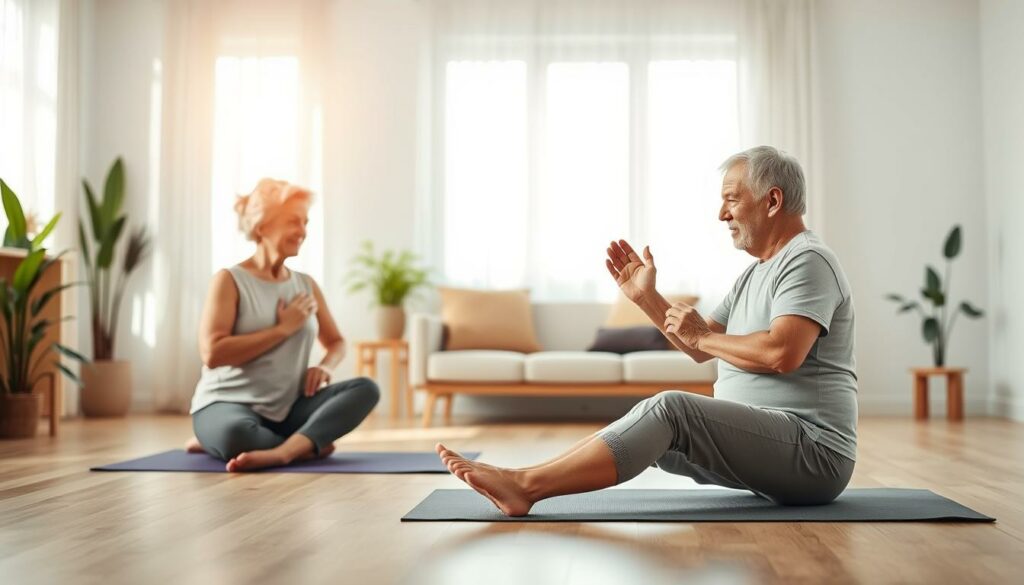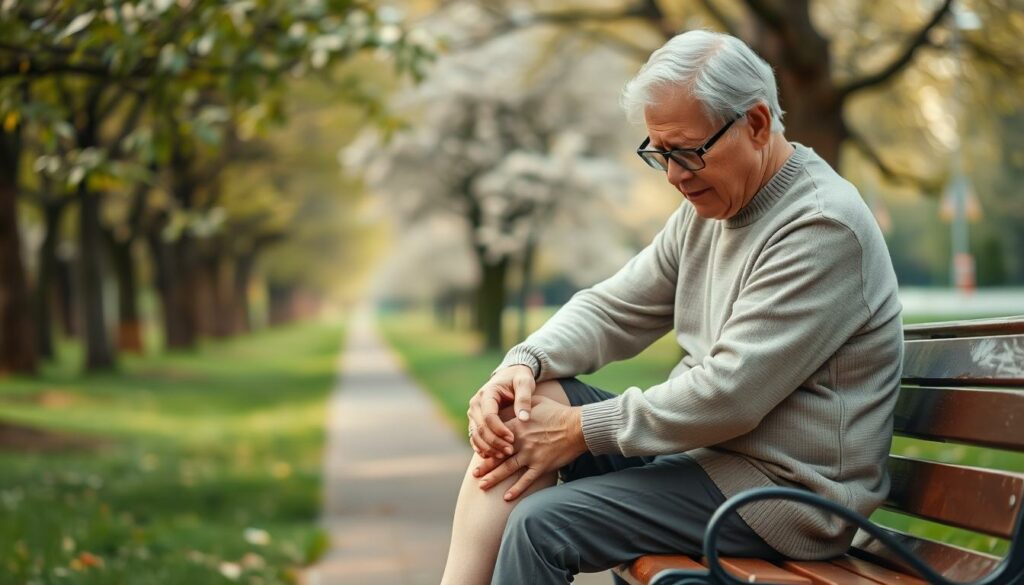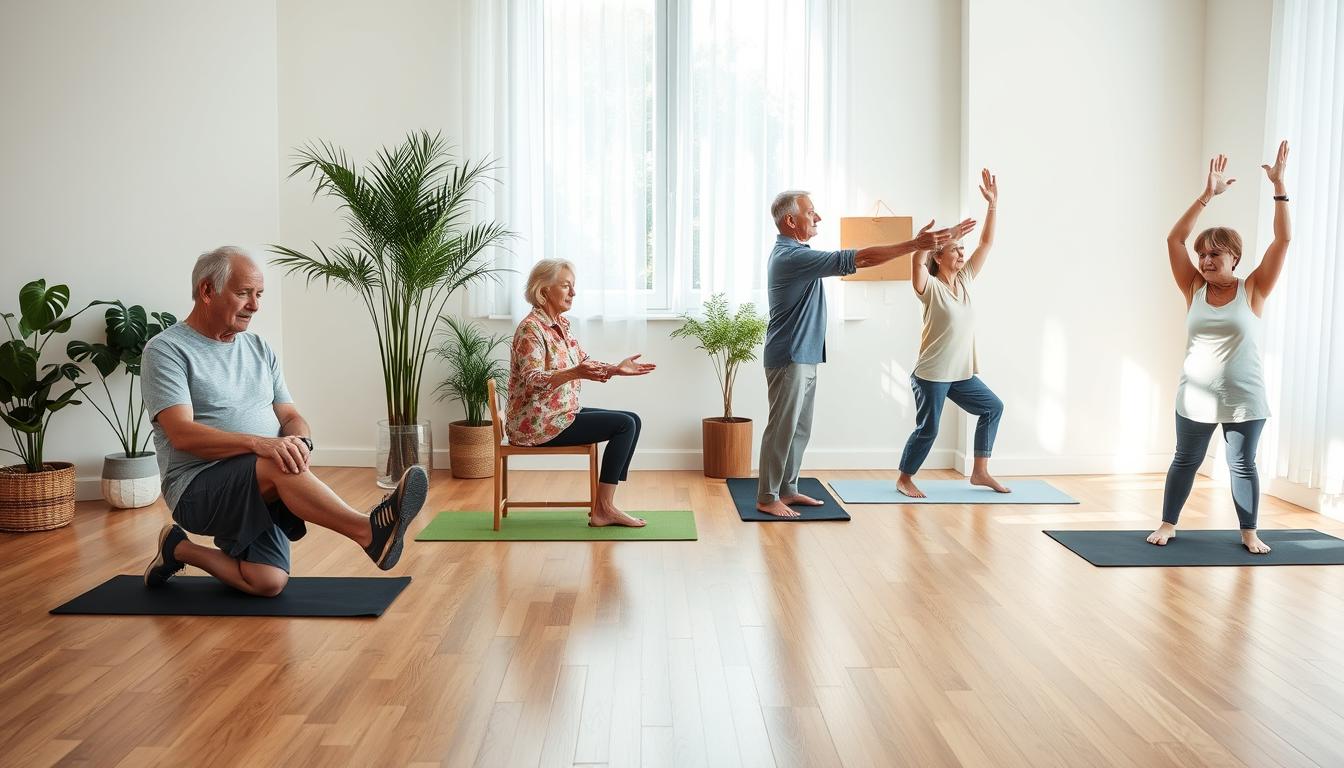Did you know knee arthritis symptoms can start as early as age 45? As we get older, knee pain becomes more common. This is due to being overweight, having a family history of arthritis, and joint wear and tear. Every extra pound adds three more pounds of pressure on your knees, causing discomfort and mobility issues for seniors.
But, you don’t have to suffer in silence. There are effective knee pain exercises for seniors that can make a big difference. These exercises are designed to help you feel better and move more easily.
Incorporating knee pain relief exercises into your routine can greatly improve your life. These exercises strengthen the muscles around your knee joints. This can help reduce pain and improve stability. Whether you need gentle exercises for the elderly or more intense ones, this article will show you the eight best exercises for your knee health.
Key Takeaways
- Knee arthritis symptoms can begin at age 45.
- Being overweight adds significant pressure on knees.
- Exercises like wall squats and knee extensions provide relief.
- A good exercise program includes strength, flexibility, and cardiovascular exercises.
- Regular physical activity can improve mobility and reduce pain.
The Importance of Knee Health for Seniors
Knee health is key to a better life as you get older. Strong and stable knees help you stay independent. They let you enjoy simple things like walking and hobbies.
Knowing what causes knee pain is important. It helps you manage your symptoms better.
Understanding Common Causes of Knee Pain
Many things can cause knee pain in seniors. Some common ones are:
- Osteoarthritis: A disease where the cartilage in your knee wears down.
- Previous injuries: Old injuries, like fractures or torn ligaments, can cause ongoing pain.
- Rheumatoid arthritis: An autoimmune disease that makes your joints inflamed, affecting your knee.
Knowing these causes helps you find the right knee pain management for seniors plan for you.
How Knee Pain Affects Mobility
Knee pain can really limit your movement. It makes everyday tasks hard. It can also make you more likely to fall.
It’s important to tackle mobility issues in older adults. Doing exercises that strengthen your knees can help. These exercises can reduce knee pain by 40% in just four weeks.
| Factor | Description |
|---|---|
| Osteoarthritis | Degenerative joint disease causing cartilage deterioration. |
| Previous Injuries | Long-term complications from past fractures or ligament tears. |
| Rheumatoid Arthritis | Autoimmune condition leading to joint inflammation. |
Knee Pain Exercises For Seniors

Keeping knees healthy is key for seniors. It affects how well they move and their overall happiness. Doing exercises that target the knees strengthens the muscles and reduces pain. This makes moving easier and helps keep joints working well.
Benefits of Targeted Exercises
Exercises made for seniors with knee issues have many benefits. They help build strength, stability, and improve how far you can move your knee. These exercises can:
- Reduce knee pain during daily activities.
- Enhance muscle strength around the knee joint.
- Improve flexibility and mobility.
- Promote better posture and alignment.
- Boost overall quality of life by enabling more active participation in daily tasks.
Recommended Exercise Frequency
Doing exercises regularly is important for seniors. Aim for two 20-minute sessions a week to see improvements in knee health. Start with low-impact activities like water aerobics or gentle stretching. As you get stronger, you can do more intense exercises. Here are some good ones:
- Seated knee extensions: Repeat 10 times on each leg, up to three sets.
- Calf raises: Repeat this exercise 10 times, up to three sets.
- Side steps: Advised to repeat this exercise 10 times for three sets.
- Pillow squeeze: Squeeze a pillow between the knees for two sets of 10 repetitions.
- Calf stretches: Suggested to repeat the stretching exercise twice on each leg.
- Walking: Encourage gradual increases in steps each day.
Starting slow with exercises can really help your knees. Doing these exercises often can make your life happier and healthier.
Common Symptoms Associated with Knee Pain

Knowing the signs of knee pain can really help your life. For seniors, spotting these symptoms early is key. It can lead to quick medical help and better management. Look out for…
Dull or Sharp Pain During Movement
Knee pain in seniors can vary. It might feel like a dull ache or a sharp pain, mostly when moving. This can make simple tasks hard and add to knee pain symptoms in seniors. Catching these signs early helps find the right treatment.
Swelling and Stiffness
Swelling and stiffness often go hand in hand with knee pain, often after sitting or resting for a while. These signs might mean you have knee arthritis, common in older adults. Moving regularly can help reduce stiffness and stop more pain.
Reduced Range of Motion
Another big sign of knee problems is trouble moving. Trouble bending or straightening the knee can make everyday actions tough. This could be due to arthritis or mechanical issues in the knee.
Effective Knee Pain Relief Exercises

Seniors with knee pain need to do exercises to stay mobile and feel good. These exercises strengthen the muscles around the knee and improve flexibility. This makes everyday tasks easier.
Seated Knee Extensions
Seated knee extensions are simple and very helpful for seniors. You can do them sitting in a chair. They work on the quadriceps by lifting and lowering the leg.
This exercise is great because it strengthens without hurting the joints. It’s perfect for seniors who sit a lot.
Straight Leg Raises
Straight leg raises are also great for seniors. They strengthen the leg without stressing the knees. You lie on your back and lift one leg at a time.
This exercise builds strength in the quadriceps and hamstrings. It also helps with balance. You can adjust how hard you do it based on how you feel.
Body Weight Squats
Body weight squats help with functional strength. They help seniors stay balanced and flexible. It’s important to do them carefully.
They make the legs and knees stronger. This is a key part of any exercise plan.
| Exercise | Description | Benefits |
|---|---|---|
| Seated Knee Extensions | Lift leg while seated in a chair | Strengthens quadriceps without stressing joints |
| Straight Leg Raises | Lift leg while lying on your back | Engages entire leg and improves balance |
| Body Weight Squats | Squat using support as needed | Enhances functional strength in legs and knees |
Senior Knee Strengthening Exercises

Incorporating senior knee strengthening exercises into your routine can greatly improve your knee health. These activities boost strength and stability in the knees. This leads to a better quality of life as you age. Here are some key exercises to add to your weekly schedule.
Leg Curls
Leg curls target the hamstring muscles, which are key for knee stability. This exercise supports the knee joint while improving flexibility and strength. Start with 3 sets of 10 reps, focusing on proper form. Gradually increase the resistance as your strength grows.
Calf Raises
Calf raises are great for knee support. They work your calf muscles, boosting balance and mobility. Stand with feet shoulder-width apart, lift heels, and hold for a moment. Lower them back down and repeat for 2 to 3 sets of 10 to 15 reps. Doing calf raises 2 to 3 times a week helps a lot.
Pillow Squeeze
Pillow squeeze exercises strengthen the inner thigh muscles, improving knee stability. Place a pillow between your knees and squeeze gently while sitting or lying down. Hold for 5 seconds, then release. Aim for 3 sets of 10 reps to strengthen the adductor muscles and control the knee joint better.
Adding these exercises to your routine supports knee health. In four to six weeks, you’ll build a strong foundation for daily activities. Always listen to your body and seek a healthcare professional if you feel pain during exercises.
Gentle Knee Exercises for Elderly

Seniors can greatly benefit from gentle knee exercises. These low-impact exercises help improve knee health and mobility. They focus on building strength and flexibility without putting too much strain on the joints. Here are three simple exercises that can be added to a daily routine.
Wall Squats
Wall squats are great for seniors. They work the quadriceps without putting too much stress on the knees. To do this exercise:
- Stand with your back against a wall and feet shoulder-width apart.
- Slowly slide your back down the wall until your knees are at about a 90-degree angle.
- Hold the position for 10 to 30 seconds, then slide back up.
- Repeat 5 to 10 times.
Side Steps
Side steps are excellent for improving lateral stability and engaging the hip muscles. They are a great choice for seniors. Here’s how to do side steps:
- Stand straight with your feet together.
- Step to the right side with your right foot, then bring your left foot to meet it.
- Repeat this motion 10 to 15 times, then switch to the left side.
Bridging
The bridging exercise strengthens the gluteal muscles and the core. It provides essential support to your knee joints. It’s simple and effective:
- Lie on your back with knees bent and feet flat on the floor, shoulder-width apart.
- Lift your hips towards the ceiling, squeezing your glutes.
- Hold for 5 seconds, then lower back down.
- Repeat 10 to 15 times.
Regularly doing these exercises can improve knee strength and mobility. It enhances quality of life and reduces injury risk.
| Exercise | Repetitions | Notes |
|---|---|---|
| Wall Squats | 5-10 times | Hold for 10-30 seconds |
| Side Steps | 10-15 times each side | Focus on stability |
| Bridging | 10-15 times | Hold for 5 seconds each time |
Incorporating Balance Exercises for Older Adults

Keeping your balance is key to avoiding falls as you get older. Falls can cause serious injuries and lower your quality of life. Doing balance exercises can make daily tasks safer and easier. It also helps you stay independent and feel more confident.
The Importance of Balance in Fall Prevention
Studies show that balance exercises can greatly reduce fall risks. For example, a 2016 study found that older adults who did balance training for six weeks got better at balancing and felt more confident. Over 25 percent of adults 65 or older fall each year, so it’s very important to have good balance.
Recommended Balance Exercises
Adding specific balance exercises to your routine can be very beneficial. Here are some good ones to try:
- Single-leg stands: Stand on one leg while holding onto something stable. Try to stay balanced for 10-30 seconds before switching legs.
- Tandem stand: Stand with one foot in front of the other. Hold this stance for 10-30 seconds, getting better with time.
- Walking in tandem: Walk with one foot in front of the other, making sure each step is steady.
- Standing march: Lift each knee while standing on the other leg, testing your balance.
If you have arthritic knees, start slowly and gradually get harder. Start with simple exercises and add more as you get better. Do these exercises two to three times a week. Always have someone with you for safety.
These exercises can improve your physical and mental health. Doing chair yoga or tai chi along with balance exercises can also help. They can make you stronger and less likely to fall.
Tips for Safe Exercise Practices

It’s important for seniors to exercise safely to stay active and manage knee pain. Knowing how to exercise safely can make your workouts better. Following a few key rules can help you handle knee problems well.
Consulting Health Professionals
Always talk to health experts before starting to exercise. They can give you advice and suggest exercises that fit your needs. A physical therapist can create a plan that’s safe for you.
Listening to Your Body
It’s important to listen to your body. Ignoring pain can cause more harm. Tips for exercising with knee pain include stopping if it hurts more. Move slowly and carefully to stay safe and effective.
Hydration and Nutrition for Joint Health
Drinking enough water is key for joint health. Also, eating right can help your exercise. Eat foods that fight inflammation like fatty fish, nuts, and leafy greens. Good nutrition and hydration help manage knee pain.
| Practice | Benefit |
|---|---|
| Consult Health Professionals | Receive tailored advice and safe exercises |
| Listen to Your Body | Prevent further injury and manage pain |
| Stay Hydrated | Support overall joint health and functionality |
| Maintain Good Nutrition | Reduce inflammation and enhance recovery |
Conclusion
Managing knee pain is key for seniors, and exercises play a big role. By doing specific knee exercises daily, you can move better and feel less pain. This lets you do more in your day-to-day life.
Studies show these exercises can really help. They can improve your knee function and even make your quadriceps stronger. This is good news for anyone dealing with knee issues.
It’s important to keep up with exercises like seated knee extensions and water aerobics. These not only help your knees but also boost your overall health. Even simple things like walking and balance exercises can make a big difference in your life.
Remember, the key is to be consistent and do these exercises right. By sticking to it and listening to your body, you can manage your knee pain well. Try these tips, and you might find a way to live a healthier, happier life.
** Our website contains affiliate links. This means if you click and make a purchase, we may receive a small commission. Don’t worry, there’s no extra cost to you. It’s a simple way you can support our mission to bring you quality content.
FAQ
What are the best knee pain exercises for seniors?
Effective knee pain exercises for seniors include seated knee extensions and straight leg raises. Body weight squats and gentle wall squats are also good. These exercises strengthen the muscles around the knee without straining the joints too much.
How often should seniors do knee pain relief exercises?
Seniors should aim for at least two 20-minute sessions of knee pain relief exercises each week. This helps improve knee strength and mobility consistently.
Are there specific exercises for seniors with arthritis?
Yes, seniors with arthritis can benefit from low-impact exercises. Gentle knee stretches, leg curls, and side steps are good. These exercises help with flexibility and strength without making the pain worse.
What should I do if I feel pain while exercising?
If you feel pain while exercising, stop right away and talk to a health professional. It’s important to listen to your body and not push too hard to avoid injuries.
Can balance exercises help with knee pain?
Yes, balance exercises are great for fall prevention and can strengthen knee-supporting muscles. Activities like single-leg stands and toe raises can improve stability.
Is hydration important for knee health?
Yes, staying hydrated is key for joint health, including your knees. Drinking enough water helps keep the joints lubricated, which can reduce pain and improve mobility.
What are some gentle knee exercises for elderly individuals?
Gentle knee exercises for elderly individuals include seated knee extensions, wall squats, and bridging. These low-impact exercises help improve strength and flexibility while reducing injury risk.
How can I integrate these exercises into my daily routine?
Start by setting specific days and times for your knee exercises. Try to do short exercise breaks throughout the day. For example, do seated knee extensions while watching TV or gentle stretches after sitting.


This blog post offers a great overview of knee pain relief strategies for seniors. It highlights effective exercises, their benefits, and safe practices, making it a helpful resource.
My Experience:As a truck driver, I’ve dealt with knee stiffness from sitting long hours. Simple exercises like seated knee extensions and calf raises during breaks have eased discomfort and improved flexibility.
Discussion:I appreciate the focus on strengthening muscles and improving balance to prevent falls. The tips on hydration and nutrition for joint health are also valuable and often overlooked.
Opinion:This guide is clear and beginner-friendly. The FAQs address common concerns, making it easy to follow. Adding tips for those with severe arthritis or mobility issues could make it even better. Overall, it’s an informative and motivating read!
Hi Shawn,
Thank you for sharing your experience and thoughtful feedback! It’s great to hear how seated knee extensions and calf raises have helped you as a truck driver—those small efforts during breaks really do make a difference.
I agree that strengthening muscles and improving balance are crucial, especially for fall prevention. Your point about hydration and nutrition is spot on; these often get overlooked but are essential for joint health. Including tips for severe arthritis or mobility challenges is a fantastic suggestion—it would make the guide even more inclusive.
I’m curious, have you found any other exercises or routines particularly helpful in managing knee stiffness during long drives?
Cheers
John